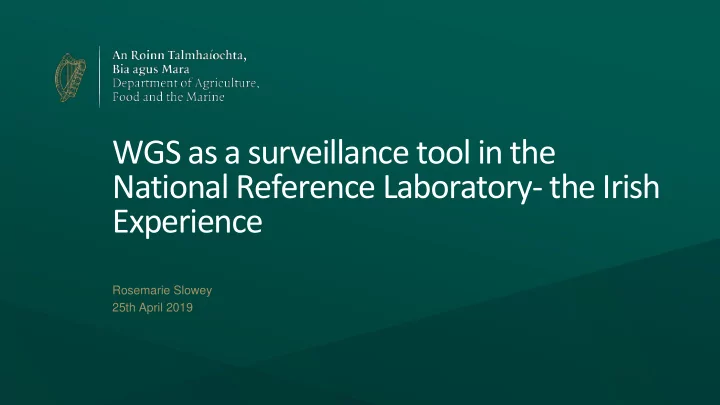

WGS as a surveillance tool in the National Reference Laboratory- the Irish Experience Rosemarie Slowey 25th April 2019
State Veterinary Service
Introduction of WGS in the AMR NRL • Began in 2016 • Illumina Miseq – shared with NRLs for Campylobacter, Salmonella, Listeria, S. aureus and E. coli as well as virology division • Aim: implementation of WGS as a routine typing tool • Initial setup – postdoc from University College Dublin, support from Illumina
WGS Workflow • Ultraclean microbial DNA isolation kit • MagNa Pure (Gram negative) DNA Extraction Library prep • Nextera XT → Flex kit Sequencing • V3 kit • Bionumerics Assembly • Bionumerics, Blast, CGE tools Analysis
Staff Initial Challenges • 2 Laboratory analysts, 1 research • Clustering related to DNA extraction officer method for Gram negatives • Issues with Qubit calibration • Training from Illumina, Applied Maths, EURLs • IT security issues – FTP, Basespace, CGE access To date 10 Campylobacter, 35 Enterococcus, 250 E. coli and 220 • New server- data storage Salmonella sequenced • Computer upgrades required • Bionumerics affected by network speed
Why do we use WGS? 1. To validate results of AST testing before inclusion in EUSR/ national one health report 2. To assess trends and screen for emerging genotypes 3. To contribute towards enhanced AMR surveillance (National Action Plan) 4. To provide more robust data to inform stakeholders-colleagues formulating policy, prescribing vets and farmers
To validate results of AST testing No ESBL genes S. Orion Identified in 4 CTX, Caz Res of 156 No ESBL genes presumptive Identified positive ESBL E. coli High IMI/ ETR/TEM MIC ESBL genes blaCMY-2 or present in all Amp C 13 isolates promoter 11x bla CTX-M- region 1 mutations 2 x bla SHV-2
To assess trends EUSR 2016 - prevalence of ESBL-producing E. coli from broilers Proportion of broiler caecalsamples positive for presumptive ESBL- producing E. coli
ESBLs in broiler E. coli isolates BlaCTX-M-1 and BlaSHV-12 predominated, with diverse ST-types blaSHV-12 isolates blaCTX-M-1 isolates
ESBLs in broiler E. coli isolates ctd . % isolates containing IncI1 blaCTX-M-1 • 50% CTX-M-15+ Sul2+Tet(A) and IncF Plasmids • 57% aadA5/ dfrA17 class 1 integron blaCTX-M-1(n=69) blaSHV-12 (n=20) IncI1 94 50 ST-3 84 0 BlaSHV-1 ST26 or 36 0 35 • 66%- QnrS1 IncF 74 65 F43:A:B- 15 0 No O1/ O2/O78 strains 37% of 2018 isolates EAST-1 positive
Current situation
To screen for emerging genotypes EUSR 2017 - prevalence of ESBL-producing E. coli from fattening pigs • blaCTX-M-15 • Prevalence of ESBL- associated with producing E. coli ISEcp1 lower in pigs (18%) • Prevalence of blaCTX- • Variable resistance M-15 in pig E. coli gene combinations increased from 2015 to 2017 • IncF, IncY, Col plasmids • No ST131
To provide more robust data to inform stakeholders-case study History : Beef suckler herd of 50 - 60 cows and calves lost 11 cows and 31 calves between 2015-17 Presentation : enteritis in young calves, post caesarean infections unresponsive to antimicrobial treatment Post- mortem findings - MDR E. coli isolated from internal organs and faeces Was this the cause of mortality? Treatment options?
Phenotype WGS Results 1 isolate ST-10 – WGS AMP-CHL-CIP-GEN-NAL-SMX-TET-TMP Virulence factors: F17a 3 Isolates ST-88 with mutations in the AmpC promoter region AMP-CTX-CAZ-CIP-CHL-GEN-NAL-SMX-TET-TMP Amp-C Phenotype Virulence Factors: EAST-1, CS31A , microcin M part of colicin H, siderophore receptors, extracellular serine protease and increased serum survival, adherence protein and long polar fimbrae .
Where has WGS been most useful in our lab? • Rapid confirmation of genotypes from assemblies • More efficient than AST testing of less common and fastidious bacteria ( Pasteurella multocida ) • Less time consuming than individual ESBL PCRs + Sanger sequencing • Additional information- not just AMR • Provides information on what resistance genes are- and are not circulating
The Challenges • QC of data without bioinformatician • What to do with “grey hits”? • Still takes 7 working days from culture to assembled files • Failed runs Entry N50 NrContigs AvgDeNovoCover Length 1 69596 161 73.0 2875005 • Extra costs- software and 2 30240 450 53.9 5468620 3 15971 983 35.7 5369509 4 5063 2772 34.5 6172247 contracts 5 54598 213 89.2 2712757
Final Thoughts • WGS EQAS like GMI PT will be essential • No hits ≠ no resistance genes • Support will be required from EURL • Amount of information can be overwhelming
Acknowledgements Thanks to my colleagues in the AMR NRL and the veterinary laboratory service, DAFM.
Recommend
More recommend